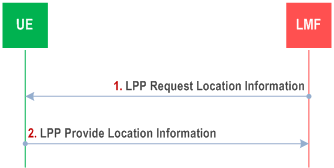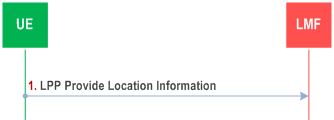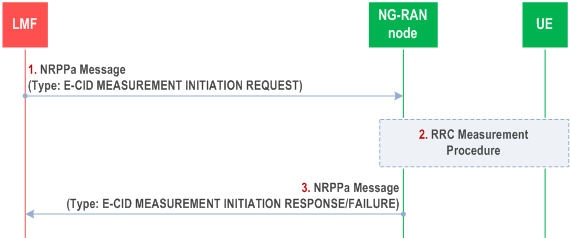Content for TS 38.305 Word version: 18.3.0
1…
4…
5…
6…
6.5…
6.7…
7…
7.3A…
7.4…
7.6…
7.11…
7.12…
8…
8.1.2.1a…
8.1.3…
8.2…
8.3…
8.4…
8.5…
8.6…
8.7…
8.8…
8.9…
8.10…
8.11…
8.12…
8.13…
8.14…
8.15…
A…
8.3 Enhanced cell ID positioning methods
8.3.1 General
8.3.2 Information to be transferred between NG-RAN/5GC Elements
8.3.2.0 General
8.3.2.1 Information that may be transferred from the LMF to UE
8.3.2.2 Information that may be transferred from the ng-eNB to LMF
8.3.2.3 Information that may be transferred from the gNB to LMF
8.3.2.4 Information that may be transferred from the UE to LMF
8.3.3 Downlink E-CID Positioning Procedures
8.3.3.0 General
8.3.3.1 Capability Transfer Procedure
8.3.3.2 Assistance Data Transfer Procedure
8.3.3.3 Location Information Transfer Procedure
8.3.3.3.1 LMF-initiated Location Information Transfer
8.3.3.3.2 UE-initiated Location Information Delivery procedure
8.3.4 Uplink E-CID Positioning Procedures
8.3.4.0 General
8.3.4.1 Capability Transfer Procedure
8.3.4.2 Assistance Data Transfer Procedure
8.3.4.3 Position Measurement Procedure
8.3.4.3.0 General
8.3.4.3.1 LMF-initiated Position Measurement
...
...
8.3 Enhanced cell ID positioning methods p. 97
8.3.1 General p. 97
In the Cell ID (CID) positioning method, the UE position is estimated with the knowledge of the geographical coordinates of its serving ng-eNB or gNB.
Enhanced Cell ID (E-CID) based on LTE signals positioning refers to techniques which use UE and/or NG-RAN radio resource related measurements to improve the UE location estimate. In the case of a serving ng-eNB, uplink E-CID may use inter-RAT NR, GERAN, UTRA or WLAN measurements reported by UE.
E-CID measurements for E-UTRA may include [17], [18]:
UE measurements (TS 36.214, TS 36.302):
- E-UTRA Reference signal received power (RSRP);
- E-UTRA Reference Signal Received Quality (RSRQ);
- UE E-UTRA Rx - Tx time difference;
- GERAN RSSI;
- UTRAN CPICH RSCP;
- UTRAN CPICH Ec/Io;
- WLAN RSSI.
- SS Reference signal received power (SS-RSRP);
- SS Reference Signal Received Quality (SS-RSRQ);
- ng-eNB Rx - Tx time difference;
-
Timing Advance (TADV):
- Type1: TADV = (ng-eNB Rx - Tx time difference) + (UE E-UTRA Rx - Tx time difference);
- Type2: TADV = ng-eNB Rx - Tx time difference;
- Angle of Arrival (AoA).
8.3.2 Information to be transferred between NG-RAN/5GC Elements p. 98
8.3.2.0 General |R18| p. 98
This clause defines the information that may be transferred between LMF and UE/NG-RAN node.
8.3.2.1 Information that may be transferred from the LMF to UE p. 98
UE-assisted Enhanced Cell-ID location does not require any assistance data to be transferred from the LMF to the UE.
UE-Based Enhanced Cell-ID location is not supported in this version of the specification.
8.3.2.2 Information that may be transferred from the ng-eNB to LMF p. 98
The information that may be signalled from ng-eNB to the LMF is listed in Table 8.3.2.2-1.
| Information |
|---|
| Timing Advance (TADV) |
| Angle of Arrival (AoA) |
E-UTRA Measurement Results List:
|
GERAN Measurement Results List:
|
UTRA Measurement Results List:
|
WLAN Measurement Results List:
|
NR Measurement Results List:
|
Both cell-level and beam-level measurements for SS-RSRP and SS-RSRQ are supported.
8.3.2.3 Information that may be transferred from the gNB to LMF p. 99
The information that may be signalled from gNB to the LMF is listed in Table 8.3.2.3-1.
| Information |
|---|
NR Measurement Results List:
|
8.3.2.4 Information that may be transferred from the UE to LMF p. 99
The information that may be signalled from UE to the LMF is listed in Table 8.3.2.4-1.
| Information | UE-assisted |
|---|---|
| Evolved Cell Global Identifier (ECGI)/Physical Cell ID | Yes |
| E-UTRA Reference signal received power (RSRP) | Yes |
| E-UTRA Reference Signal Received Quality (RSRQ) | Yes |
| UE E-UTRA Rx - Tx time difference | Yes |
8.3.3 Downlink E-CID Positioning Procedures p. 100
8.3.3.0 General |R18| p. 100
The procedures described in this clause support E-CID related measurements obtained by the UE and provided to the LMF using LPP. The term "downlink" is intended to indicate that from the LMF perspective the involved measurements are provided by the UE; this set of procedures might also be considered as "UE-assisted, LMF-based E-CID".
8.3.3.1 Capability Transfer Procedure p. 100
The Capability Transfer procedure for E-CID positioning is described in clause 7.1.2.1.
8.3.3.2 Assistance Data Transfer Procedure p. 100
Assistance data transfer is not required for E-CID positioning.
8.3.3.3 Location Information Transfer Procedure p. 100
The purpose of this procedure is to enable the LMF to request position measurements from the UE, or to enable the UE to provide location measurements to the LMF for position calculation.
8.3.3.3.1 LMF-initiated Location Information Transfer p. 100
Figure 8.3.3.3-1 shows the Location Information Transfer operations for the E-CID method when the procedure is initiated by the LMF.

Step 1.
The LMF sends a LPP Request Location Information message to the UE for invocation of E-CID positioning. This request includes the E-CID measurements requested by the LMF and supported by the UE as listed in Table 8.3.2.4-1 together with a required response time.
Step 2.
The UE sends an LPP Provide Location Information message to the LMF and reports the requested measurements that are available in the UE before the Response Time provided in step (1) elapsed. If the requested measurements are not available, or if the Response Time provided in step 1 elapsed before any of the requested measurements have been obtained, the UE returns any information that can be provided in an LPP message of type Provide Location Information which includes a cause indication for the not provided location information.
8.3.3.3.2 UE-initiated Location Information Delivery procedure p. 100
Figure 8.3.3.3.2-1 shows the Location Information Delivery procedure operations for the E-CID method when the procedure is initiated by the UE.

Step 1.
The UE sends an LPP Provide Location Information message to the LMF. The Provide Location Information message may include any UE measurements already available at the UE.
8.3.4 Uplink E-CID Positioning Procedures p. 101
8.3.4.0 General |R18| p. 101
The procedures described in this clause support E-CID related measurements obtained by the NG-RAN node and provided to the LMF using NRPPa. The term "uplink" is intended to indicate that from the LMF point of view, the involved measurements are provided by the NG-RAN node; this set of procedures might also be considered as "NG-RAN node-assisted E-CID". An example of this uplink E-CID positioning method for E-UTRA is AoA+TADV.
8.3.4.1 Capability Transfer Procedure p. 101
The Capability Transfer procedure is not applicable to uplink E-CID positioning not using E-UTRA TADV type 1. For uplink E-CID positioning using E-UTRA TADV type 1, the Capability Transfer procedure for E-CID positioning is described in clause 7.1.2.1.
8.3.4.2 Assistance Data Transfer Procedure p. 101
The assistance data transfer procedure is not applicable to uplink E-CID positioning.
8.3.4.3 Position Measurement Procedure p. 101
8.3.4.3.0 General |R18| p. 101
The purpose of this procedure is to enable the LMF to request position measurements from the NG-RAN node.
8.3.4.3.1 LMF-initiated Position Measurement p. 101
Figure 8.3.3.3.2-1 shows the position measurement operations for the uplink E-CID method when the procedure is initiated by the LMF.

Step 1.
The LMF sends a NRPPa E-CID MEASUREMENT INITIATION REQUEST message to the NG-RAN node. This request includes indication of E-CID measurements requested and whether the result is expected only once or periodically.
Step 2.
If the LMF in step (1) requested UE measurements (e.g., E-UTRA RSRP, E-UTRA RSRQ measurements, etc.), the NG-RAN node may configure the UE to report the measurement information requested as specified in TS 36.331, TS 38.331.
Step 3.
If the result is expected only once and the NG-RAN node initiates at least one of the E-CID measurements as requested, the NG-RAN node sends an NRPPa E-CID MEASUREMENT INITIATION RESPONSE to the LMF, which includes the obtained E-CID measurements. If the result is expected periodically and the NG-RAN node is able to initiate at least one of the E-CID measurements as requested, the NG-RAN node sends an NRPPa E-CID MEASUREMENT INITIATION RESPONSE to the LMF, which does not include any result. The NG-RAN node reports then the obtained measurements by initiating the E-CID Measurement Report procedure, with the requested periodicity. If the NG-RAN node is unable to initiate any of the requested measurements as requested from the LMF, or is unable to instigate any of the required RRC procedures to obtain the requested measurements from the UE, the NG-RAN node sends an NRPPa E-CID MEASUREMENT INITIATION FAILURE message providing the error reason. If the failure occurs during a periodic reporting, the NG-RAN node sends an NRPPa E-CID MEASUREMENT FAILURE INDICATION message.